hydropower turbine propeller:
- Part 1: Parameters and operating parts of a turbine system.
- Part 2: The relation stator guide vanes and propeller
- Part 3: The design method of hydraulic turbine
- Part 4: Tutorial designing a turbine system.
- Tutorial hydroelectric turbine design 1/3 :Site power and turbine design
- Tutorial hydroelectric turbine design 2/3 :Design :guide vanes or stator
- Tutorial hydroelectric turbine design 3/3 :Choice sections, design draft tube
Tutorial hydroelectric turbine design 1/3 :Site power and turbine design
1: Power of the site:
In this tutorial example, we take the case of the development of a site which has an average flow of 12 m3/sec with a drop height of about 4 meters.
Evaluate the power of undeveloped site:
- The flow will be measured by the speed of the flow and the flow section of the river. a page comprising various methods of measuring river flow was created).For our example, the flow rate is 12 m3/sec.
- The head is created by the dam water. Although the propeller or Kaplan turbines types are intended for low drop height, a minimum height is needed to balance the pressure drops and produce pressure required to operate the guide vanes or stator and passing through the turbine.This height will be produced by the gradient between the upstream and downstream basinthe civil engineering work will be composed of a diversion dam, low height for installations throughout water . Made of concrete, wood or masonry, the cost of the dam alone can render the project unviable. The height of gross to create the dam fall, will be given by the study of the turbine. For our example, the head is estimated to be 4 meters
Ph hydraulic power in watts, of the site depends:
- The difference in height of fall H in meters, between the surfaces of the upstream and downstream basin.
- The flow rate Q in m3/sec, through the system.
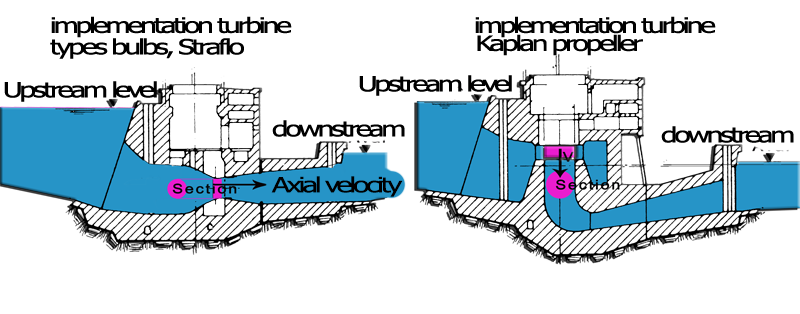
- Head (meters) = upstream altitude -Downstream altitude
- Flow rate (m3/sec)= axial velocity(m/sec) * Section (m²)
- Hydraulic power Ph(watts)=Q*H*g*ρ
with :
Hydraulic raw power of our site can be evaluated : 12 X 4 X 9.81 X 1000 = 470 880 Watts (471 Kw). We will see that because of the various losses, the electrical power produced will be lower. The division of power produced by the raw power, give the overall performance of our system.
- ρ water density (1000 kg/m3)
- Section =fluid passage section (area swept by the turbine) m²
- g (9.81 m/s²)
- Q turbine flow in m3/s
- H Head m
2: Design of the propeller turbine.
As stated in the proposed method, nous commencerons par calculer notre hélice optimum pour le débit de 8 m3/sec. For this we use the HELICIEL software to obtain performance and 3D models of blades that we will build.
- We are launching Heliciel and open a new project hydraulic turbine type:

- In tab1.1: specifications / Fluid , we select as fluid, water (eau H2O) at 10 °:
- In tab 2.2 profile law, ensure that the law profile is "constant profile" and that the profile is "naca 1408." (otherwise adjust)

- Under the 3:Optimize tab, set the number of blades of the turbine, on 4 .

- Under the tab 1:Project specification / 1.3:Operating point, we will give as a starting value, a speed (axial) of 6m/sec and a rotational speed of 100 rev / min. We will change these settings later to adjust our propeller.

- Select the blade geometry / dimensions blade tab to enter the radius blade tip and blade root radius(diameter of the propeller, and the hub): By varying the swept section, we will control the axial velocity for the given flow 12 m/sec.
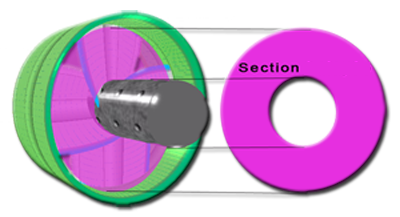
- Velocity axiale(m/sec) = flow (m3/sec) / swept section (m²)
enter the basic parameters:
- Blade tip radius=1000mm
- Radius blade root= 60% (600mm)
- Chord blade root= 738 mm
- Blade tip Chord= 1138 mm
- Click "linearize" in the distribution area of chords to get a straight blade.
- In this example we want a distribution chord giving a slightly curved blade. To achieve exactly the same distribution as this example, we can directly enter the equation for distribution of our cords in three fields provided for this purpose. Our equation is: -0.0031457 r² + 6.033248 r -1749.469 , Enter these values and click "Apply equation chords".(cords values and the equation may be slightly altered during the application of the equation)
If you have previously entered speed 6 m/sec, You should get a flow rate (top left in speed counter) 12.064.m3/sec like this:
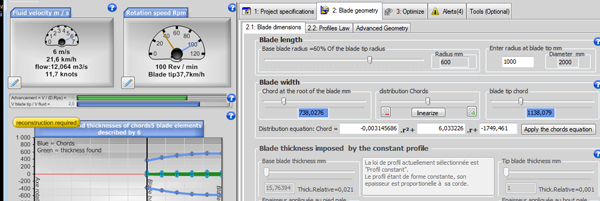
- Our turbine is penstock. The "Duct" option must be checked:
Changing the speed or blade length, leads, of course, the change in flow. We have chosen the values of velocity and length giving us the flow rate imposed 12 m3/sec..
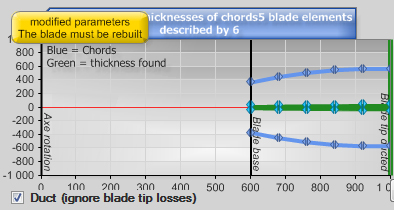
Ticking the option Duct relaunch calculation of the propeller..
- Without further ado, in the 3:Optimize tab, we are launching a search for optimum rotation speed::
Heliciel will build the optimum twist and evaluate the performance of our turbine based on a series of speed rotations tested and will stop on the optimum rotation speed, here we got a performance propeller, 0,47 at 53,19 revolutions per minute::
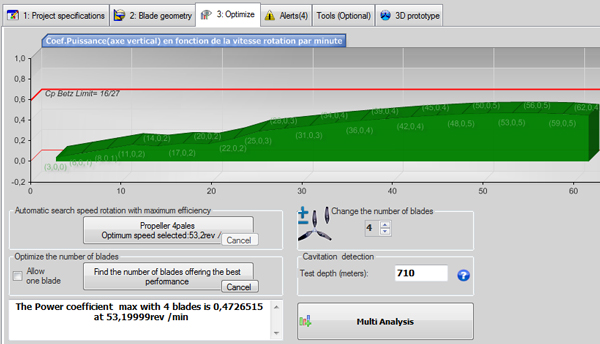
The optimum twist suitable for this operating point and the 3D model of our propeller was built. Our performance could be improved by changing the width and distribution of cords to get close to the Betz limit, but suffice 0.47 in this tutorial trying to keep it simple and fast.
We could start manufacturing the blade editing 3D IGS file... but optimizations will follow, as the introduction of a tangential velocity by the distributor(guide vanes), and creating a draft tube ...Take care to save your project, because we'll come back later..
We will now use the results of this turbine configuration for following: evaluate the effect of a tangential introduction upstream of the propeller caused by a guide vanes Tutorial hydroelectric turbine design 2/3 :Design :guide vanes or stator
hydropower turbine propeller:
- Part 1: Parameters and operating parts of a turbine system.
- Part 2: The relation stator guide vanes and propeller
- Part 3: The design method of hydraulic turbine
- Part 4: Tutorial designing a turbine system.
- Tutorial hydroelectric turbine design 1/3 :Site power and turbine design
- Tutorial hydroelectric turbine design 2/3 :Design :guide vanes or stator
- Tutorial hydroelectric turbine design 3/3 :Choice sections, design draft tube

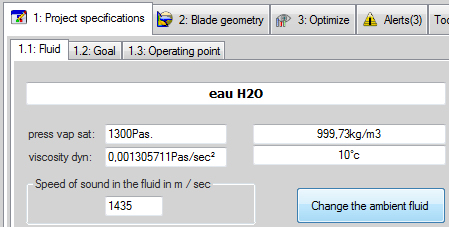
 Global site map
Global site map Mecaflux
Mecaflux Tutorials Mecaflux Pro3D
Tutorials Mecaflux Pro3D Tutorials Heliciel
Tutorials Heliciel Mecaflux Store
Mecaflux Store Compare software functions
Compare software functions Quotes, Orders, Payment Methods
Quotes, Orders, Payment Methods project technical studies
project technical studies